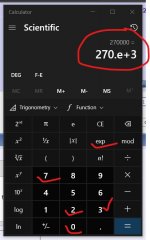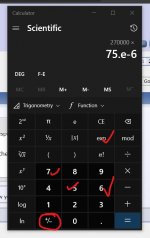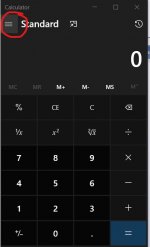ah i can see what i did wrong now, simple error i used the calculation using 270 instead of 270,000 so the decimal is in the wrong place
Erm... not quite 🙂
It should look like this.
270k is 270,000 ohms and 75uA is entered as 75E-6 on a scientific calculator. Once entered it expands out on this calculator to 0.000075
So we have 270,000 * 0.000075 giving 20.25 (volts)
i tried doing on the calculator as suggested but i cant be doing it right as it doens't exactly come out as it should🙁
well i have a proper scientific one, which i find hard to use, its just called a
HIHUHEN 2-Line Engineering Scientific Calculator
but i was trying to use the scientific one on windows
HIHUHEN 2-Line Engineering Scientific Calculator
but i was trying to use the scientific one on windows
On the Windows calculator try this.
Enter 270 and then press the exp key and then press 3. You should see the display show 270,000 like this.
Now press multiply and enter 75 and then press exp and press 6 followed by the -/+ sign to change the exponent to negative 6.
Now press = and you should get 20.25.
Your other calculator looks similar to my Casio.
1/ Enter 270 and then press that key marked EXP at the bottom followed by 3
2/ Press X (multiply)
3/ Enter 75 then EXP followed by pressing that little - key in brackets at the left. The one marked (-)
4/ Enter 6
5/ Now press = and you should get 20.25
Enter 270 and then press the exp key and then press 3. You should see the display show 270,000 like this.
Now press multiply and enter 75 and then press exp and press 6 followed by the -/+ sign to change the exponent to negative 6.
Now press = and you should get 20.25.
Your other calculator looks similar to my Casio.
1/ Enter 270 and then press that key marked EXP at the bottom followed by 3
2/ Press X (multiply)
3/ Enter 75 then EXP followed by pressing that little - key in brackets at the left. The one marked (-)
4/ Enter 6
5/ Now press = and you should get 20.25
Attachments
yep works on both NP.its all a case of i didnt have a clue how to work it 😕
im affraid maths never was my strongest subject and i never did any of this at school ,so it realy is brand new for me, all of it.
but at least now i know how to do that, thanks
im affraid maths never was my strongest subject and i never did any of this at school ,so it realy is brand new for me, all of it.
but at least now i know how to do that, thanks
Maths was (and still is) the same for me. I'm not good at all with it.
What is confusing as well is that modern calculators prioritise different functions differently to those of years ago. And there is no consistency.
Try this on your Windows PC using the standard calculator and also the scientific one. You change between them with top menu.
Enter 3+6*12=
Answers on a postcode 😉 They can't both be right... can they 😀
(One gives 108 as the answer and the other gives 75)
What is confusing as well is that modern calculators prioritise different functions differently to those of years ago. And there is no consistency.
Try this on your Windows PC using the standard calculator and also the scientific one. You change between them with top menu.
Enter 3+6*12=
Answers on a postcode 😉 They can't both be right... can they 😀
(One gives 108 as the answer and the other gives 75)
Attachments
MS Redmond has used the standard coding for---*--- in a computer keyboard being used in an arithmetical context for their calculator software app.
It makes logical sense.
It makes logical sense.
I just gave the computer calculator as an example, I have two Casio scientific calculators that give different answers to the same set of inputs... I know why... but it is darned confusing when you have grown up using one and then switch to a different one.
For example two voltages, say 1 volt and 0.5 volt and db's.
On the Windows PC and the ancient Casio I tap out:
1 divide by 0.5 equals log multiplied by 20 and get 6 db.
Do that on the new one and it comes up Syntax Error. The problem is that you have to start thinking all the time how it is different and work in a different way.
I still don't see where * comes into the Windows calculator. It isn't shown as being on any button and no keyboard is used when using the calc (use the mouse). It uses the tradition X for multiply, same as the Casio's
For example two voltages, say 1 volt and 0.5 volt and db's.
On the Windows PC and the ancient Casio I tap out:
1 divide by 0.5 equals log multiplied by 20 and get 6 db.
Do that on the new one and it comes up Syntax Error. The problem is that you have to start thinking all the time how it is different and work in a different way.
I still don't see where * comes into the Windows calculator. It isn't shown as being on any button and no keyboard is used when using the calc (use the mouse). It uses the tradition X for multiply, same as the Casio's
I just assumed you were talking about the keyboard in relation to the * when you posted the calculation that included the * and one result came to 108 as that function exists on standard keyboards.
> Enter 3+6*12=
I also do not see a keyboard issue.
The question is Order Of Operations (hey, OOO!).
Since the 1800s at least, exponents/roots come first, then multiply/divide, then add/subtract. BODMAS!
So in "3+6*12" you do the 6 times 12 first, then add 3. Answer 75.
But a simple mind might take it in order as written (ignoring hundreds of years of experience). 3 and 6 is 9, times 12 is 108.
"Many simple calculators without a stack implement chain input working left to right without any priority given to different operators, .... while more sophisticated calculators will use a more standard priority, ....The Microsoft Calculator program uses the former in its standard view and the latter in its scientific and programmer views.
I also do not see a keyboard issue.
The question is Order Of Operations (hey, OOO!).
Since the 1800s at least, exponents/roots come first, then multiply/divide, then add/subtract. BODMAS!
So in "3+6*12" you do the 6 times 12 first, then add 3. Answer 75.
But a simple mind might take it in order as written (ignoring hundreds of years of experience). 3 and 6 is 9, times 12 is 108.
"Many simple calculators without a stack implement chain input working left to right without any priority given to different operators, .... while more sophisticated calculators will use a more standard priority, ....The Microsoft Calculator program uses the former in its standard view and the latter in its scientific and programmer views.
Last edited:
That is exactly it PRR:
How would you explain that one to a child? Or me 😀
The Microsoft Calculator program uses the former in its standard view and the latter in its scientific and programmer views.
How would you explain that one to a child? Or me 😀
You are talking in the language of algerbraic expression - as obviously "simple minded " 3+6X12=108,
but using whats called "scientific expression " that comes out different.
In simple primary school addition its 108 , I take it very young children are no longer taught simple maths but go straight onto scientific ?
Adding /subtraction etc has to be taught in a simple form first for the human brain to grasp it its amazing any engineering feat was accomplished before scientific calculations/calculators instead of simple maths .
Nowadays when you ask somebody young to do ordinary calculations out comes a digital calculator instead of being taught mental arithmetic by rote .
The Ancient Egyptians used the decimal system to build the Pyramids to an accuracy that still amazes archeologists and mathematicians no "scientific" calculations in the modern sense were used .
but using whats called "scientific expression " that comes out different.
In simple primary school addition its 108 , I take it very young children are no longer taught simple maths but go straight onto scientific ?
Adding /subtraction etc has to be taught in a simple form first for the human brain to grasp it its amazing any engineering feat was accomplished before scientific calculations/calculators instead of simple maths .
Nowadays when you ask somebody young to do ordinary calculations out comes a digital calculator instead of being taught mental arithmetic by rote .
The Ancient Egyptians used the decimal system to build the Pyramids to an accuracy that still amazes archeologists and mathematicians no "scientific" calculations in the modern sense were used .
- Home
- Amplifiers
- Solid State
- questions about items in a circuit
 that's it.
that's it.


